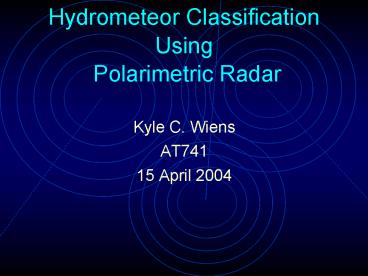Hydrometeor Classification Using Polarimetric Radar - PowerPoint PPT Presentation
1 / 24
Title:
Hydrometeor Classification Using Polarimetric Radar
Description:
This was my project last time AT741 was taught. I wrote my own algorithm from scratch. ... Trapezoid Membership Function: Zrnic et al. (2001) 2-D TMF for Moderate Rain ... – PowerPoint PPT presentation
Number of Views:105
Avg rating:3.0/5.0
Title: Hydrometeor Classification Using Polarimetric Radar
1
Hydrometeor Classification Using Polarimetric
Radar
- Kyle C. Wiens
- AT741
- 15 April 2004
2
Why me?
- This was my project last time AT741 was taught.
- I wrote my own algorithm from scratch.
- I use it in my research.
- The concepts and application of fuzzy logic are
very simple, so... - If you don't understand, it's because I'm not
explaining it well enough.
3
Outline
- Brief review of polarimetric variables.
- Combining these variables to get information
about hydrometeor types - Methods of combining these variables
- Fuzzy logic description
- Examples from 29 June 2000 supercell
4
Polarimetric Variables
- ZH Size, concentration
- ZDRShape, orientation, (liquid or solid)
- KDPAmount of liquid water, size of drops
- LDROrientation, canting, melting (wet hail)
- ?HVCorrelation (mixture of types/melting)
5
Hydrometeor Identification
- Combine variables and define sub-ranges over
which specific hydro types are expected
Straka et al. (2000)
6
Hydrometeor Identification
- Extend this concept to the six-dimensional space
(5 radar variables plus temperature)
Straka et al. (2000)
7
Combining the variables
- In a nutshell
- We have inputs (radar variables)
- We have some decision process
- We get a result (hydrometeor type)
Basically, we want the hydrometeor type that best
fits the inputs.
8
Combining the variables (the old way)
- Look-up table (decision tree), e.g.,
- IF ZHgt55
- AND (-1ltZDRlt0.5)
- AND (-0.5ltKDPlt1)
- AND (LDRgt-24)
- ...
- THEN hydrometeor Large Hail
- But this is not a good way to do it because
- Sub-ranges for each hydro type are not mutually
exclusive (i.e., they overlap) - Very inefficient and not comprehensive
9
Combining the variables(the fuzzy logic way)
- Define functions for each input variable and each
hydrometeor type. - These functions describe to what degree each
variable is a member of the hydrometeor type
family. - Another way to think of this is that each of
these functions gives a score to each input
variable. The higher the score, the greater the
membership value of that variable to that
hydrometeor type, i.e., the more likely it is
that type.
10
Types of Membership functions
- Trapezoid Membership Function Zrnic et al. (2001)
2-D TMF for Moderate Rain
11
Types of Membership functions
- Membership Beta Function Liu and Chandrasekar
(2000)
2-D MBF for rain
12
Combining the variables
- So, each variable (x) gets a score (?) based on
where it falls on the membership function for
each hydrometeor type. - Score ?(x,m,a,b)
The score is like a probability that the radar
measurement is due to that specific hydro type.
13
Liu and Chandrasekar (2000)
14
Rain!
Hail!
15
Combining the variables
- Now just combine the scores for all the variables
to get a total membership or truth value (µ)
for each hydro type. - Combine as a weighted sum
- Or as a product
- Or some combination of sums and products (which
is what I do).
16
Combining the variables(My method)
- Take weighted sum of MBFs for polarimetric
variables - Then multiply this by MBFs for ZH and temperature
to get total truth value
17
The Final Result
- So, now we have total truth values (?j) for all
hydro types. - The hydrometeor type with the highest total
truth value wins.
18
Schematic of Fuzzy Logic Process
Liu and Chandrasekar (2000)
19
Examples from 29 June 2000 Supercell
- This storm
- Produced large hail
- F1 tornado
- Well-defined BWER
- It was also very well observed by 3 radars (two
of which were polarimetric) - Also had T28 aircraft penetrations which found
hail.
20
Height 3km
21
Height 7km
22
(No Transcript)
23
LDR Cap
Zdr column
Big drops
24
Hail counts
Hail size
T28 Comparison































